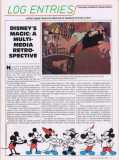He was born in Chicago in 1901. While growing up in Kansas City he became interested in animation and graphic arts. At age 27, he released a little movie with a big-earred star who soon became one of America's most popular folk heroes.
The man was Walt Disney, the film was Steamboat Willie and the beloved critter was, of course, Mickey Mouse.
From the 1930s through the early 1940s, Disney guided a close group of animators in the creation of a family of characters which included Minnie Mouse, Donald Duck, Goofy and Pluto. In the late 30s, Walt Disney Studios began releasing feature films such as Snow White and the Seven Dwarfs (1937), Pinnochio (1940), Fantasia (1940), Dumbo (1941) and Bambi (1942) — all of which set standards in the aesthetics and techniques of animation yet to be topped.
This summer, from June 24 through September 6, New York's Whitney Museum of American Art became the first museum to examine the special characteristics of Disney character animation with its exhibit, "Disney Animation and Animators."
Designed by SITE, the exhibit presented approximately 1,500 drawings, painted cels and backgrounds loaned by Walt Disney Productions and private collectors; 115 films from the period between 1932 and 1942 were shown throughout the summer. Sculptural and puppet models that were used to help create the magical characters were also displayed.
"We thought it was important that people should know what those little creatures running around were all about," says Charles Richardson, in charge of creative development at Walt Disney Productions. "One of the purposes of this exhibit was to interest young people and graphic and fine artists in the field so that they would think twice about it and seriously consider making a contribution to animation."
The specific and distinctive contributions of such animators as Art Babbitt, Ub Iwerks, Ollie Johnston, Milt Kahl, Ward Kimball, John Lounsberry, Wolfgang Reitherman, Frank Thomas and Vladimir Tytla were introduced through animation sequences that describe how each character evolved out of the drawing style of each particular artist.
A videotaped scene of The Fox and the Hound showed all steps of the animation process from conception to completed film. It is the only animated Disney project for which all of these elements have been preserved on film.
"Disney Animations and Animators" was organized by Greg Ford, Guest Curator. John Hanhardt is the museum's curator for film and video. According to Richardson, there have been inquiries from museums in Japan, Italy, France, the U.K. as well as other cities in the U.S. which are interested in hosting the exhibit. As of this writing, no definitive plans have been firmed.
